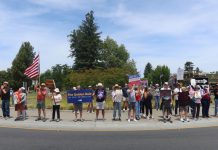“There’s no place like home,” if you have one.
Around two million Americans experience homelessness each year,
according to the 2011 Sonoma County Homeless Census.
In fact, the latest census shows a 40 percent increase in Sonoma
County’s homeless population since the last census in 2009,
representing an increase of 1,292 people. More precisely, 4,539
homeless people – the majority of which were white males between
the ages of 31 and 60 – were counted this last January, as opposed
to 3,247 in the 2009 census.
And these statistics don’t account for those who go undetected.
“This count should be considered conservative since even with the
most thorough methodology, many homeless individuals stay in
locations where they cannot be seen or counted by enumeration
teams,” the census states.
North County saw a decrease in its homeless population, West
County stayed relatively the same, and Santa Rosa, South County and
Sonoma Valley had increases in their homeless population since
2009, according to the 2011 census.
In West County in the Sebastopol area and along the Russian
River 690 people – or 15 percent of the total – were homeless at
the time of the count. Northern Sonoma County only had 284 people –
or 6.3 percent of the homeless population when the survey was
taken. This area also has more shelters, more transitional housing
and more permanent supportive housing (affordable housing that has
social services attached).
A summary from the count shows that overall, 264 unaccompanied
homeless children (under the age of 18) and 437 unaccompanied
homeless youth (18-24) were enumerated in the 2011 point-in-time
count.
Of these unaccompanied homeless children and youth, the vast
majority (99 percent) were unsheltered. Sadly, 28 percent of
homeless children and youth surveyed said they tried to stay at an
emergency shelter within the past 30 days and were turned away.
Some 21 percent of unaccompanied homeless children and youth
said an argument with family/friends was the primary cause of their
homelessness; 36 percent reported their parents were/are homeless;
44 percent had been homeless for a year or more since they last
lived in a permanent housing situation, according to the
census.
Data from the homeless count also showed that a total of 190
homeless families with children under 18 years of age were
identified in 2011, which is a 15 percent increase from 165
homeless families in 2009.
While she couldn’t explain the reason for an increase in the
number of homeless youth, Gale Brownell of the Sonoma County
Housing Coalition did say 55 percent of homeless people overall
became homeless for the first time in the past year, primarily due
to the loss of a job. “People who were homeless told us that the
major reasons they don’t have a place to live is that they cannot
afford the rent or that they don’t have a job,” she said.
Making matters worse, the funding for shelters and other
services to the homeless is decreasing again this year, Brownell
said. “We expect to lose about $400,000 in Federal Emergency
Shelter funds, and $488,000 in homeless services funding from the
Sonoma County Human Services Department is being considered for
elimination. The reduction of county general funds has resulted in
the conversion of the Russell Avenue shelter into transitional
housing serving fewer people. As it is, our shelters and
transitional housing were only able to serve 23 percent of those
who were homeless at the time of the Count,” she said.
To retain $2.5 million in federal funding for Sonoma County
homeless programs the US Department of Housing and Urban
Development requires a biennial homeless count, taken one day in
January. The 2011 census was performed Jan 28. In the weeks
following over 600 surveys of homeless people were conducted, in an
attempt to gather more detailed information about this
population.
At full scale, the goals of the county’s 10-year plan to end
homelessness by decade’s end would take $20 million annually for
crucial supportive services, rental subsidies and housing operating
expenses. “Putting a roof over every head” by year 2017, as the
plan calls for, would require $40 million in local tax funds and
builder allotments as part of an overall need for $200 million in
public-private investments.
Laura McCutcheon can be reached at la***@********st.com.








